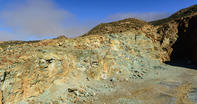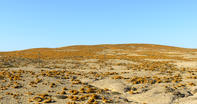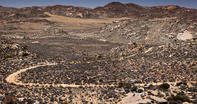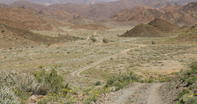Search for Copper
The first expeditions searching for the copper belt from the Cape were under the command of Olof Bergh, who pioneered a route that avoided the Olifants River Valley by moving through the Sandveld to the west, thus avoiding the barrier of dry, rocky plains that came to be known as the Knersvlakte (so named because of the sound the wagon wheels made when ‘gnashing’ over the pebbly quartzite).

He also became the first European to visit a cave north of Graafwater that soon became a regular stop on the road to the north, known as Heerenlogement (Gentlemen’s Lodging). On his first trip, Bergh reached the Groen River near Garies and on his second try, he got even farther, reaching the vicinity of the Kamiesberg. However, on both occasions, he returned to the Cape empty-handed. Then in 1684, another party of Namaqua people visited Cape Town.
This time, the Dutch governor Simon van der Stel sent a party under Sergeant Isaq Schrijver to travel back with the Namaqua. The precise route of Schrijver’s group is not known, but he did penetrate far into Namaqualand (probably to Leliefontein) and, when he returned, he presented the governor with some samples of copper ore. These were melted down and the results were sent off tothe Ducth East India Company headquarters in Holland for investigation.
Another Expedition

In the meantime, another expedition had uncovered further information about the existence of a ‘copper mountain’ which was located not too far from the sea in Namaqualand. This greatly excited Dutch governor Simon van der Stel, who promptly put together a massive expedition which he would lead himself. In 1685, with the Ducth East India Company’s blessing, the governor set off for the north with all due pomp and circumstance.
By all accounts, it was a very impressive procession. It included 57 white people, two Macassar prisoners (from Indonesia), three slaves, a carriage with six horses for the governor, eight donkeys, 14 riding horses, two artillery pieces, eight carts, seven wagons (one of which contained a boat) and 289 oxen.
There were also over 50 Khoikhoi wagon drivers, interpreters and camp followers, as well as six additional wagons each drawn by eight oxen which belonged to freemen who accompanied the expedition as far as the Olifants River. And don’t forget about all the provisions, muskets, gunpowder and barter goods that the massive party would need for their five month journey.
One member of this group, Hendrik Claudius, was an artist who produced one of the first series of illustrations featuring the plants of Namaqualand, including the kokerboom.
Unwieldy Expedition

Following the route established by Olof Bergh, Simon van der Stel pushed his team ever northwards. It was fortunate that the region was enjoying a particularly wet spring that year, so the barren wastes of the Sandveld and the mountainous Hardeveld were unusually fertile.
This helped sustain the unwieldy expedition and they made good progress. After several weeks of travelling, Van der Stel and his gang reached the Kamiesberg. Here, they spent a couple of weeks trying to recruit some local Namaqua people who could take them to the Copper Mountain. Eventually, a combination of tobacco, liquor, food and coercion secured the services of two guides who steered the party through the inhospitable hills to the north.
Eventually, on October 21st, 1685, they arrived at the ‘Koper Bergen’ located near the present-day town of Carolusberg, a short distance away from Springbok. They immediately went to work and sunk several exploratory shafts into the mountain side. The results looked very promising, with the ore improving the deeper they went. They also sent out prospecting teams who explored the area, including O’okiep.
Van Werlinckhof, the mineralogist, was particularly impressed and, after two weeks at the site, he declared that ‘I am entirely convinced of the favourable character of these mines; in the event of mining operations being continued, richer and richer, and better minerals will be found, for the hills concerned extend several miles in length and breadth, and hold minerals almost everywhere.’
Impossible to Exploit

Simon van der Stel was understandably optimistic as he rode back into Cape Town. The expedition had been a great success. They had found the copper mountain and collected numerous ore samples, which were promptly dispatched to Holland for analysis. Moreover, the difficult journey had been completed without a single loss of human life. Even the six-horse carriage had made it back in one piece, apart from a dent inflicted by a charging rhinoceros.
Unfortunately, that’s where the good news ended. The assay results from Holland were good, but not outstanding (the ore contained between 7% and 11% copper). Furthermore, the country in which the copper was located was dry and remote. There was no suitable grazing land for animals and no practical overland supply route for human provisions.
The sea was many miles away, cut off from the mine by a range of jagged mountains, and investigations of the coast between the Groen River and the Buffels River had revealed no suitable anchorages. In short, Simon van der Stel’s copper mine was impossible to exploit – at least for the time being – and no further mining activity would take place in Namaqualand for more than 150 years.
Today, a couple of Van der Stel’s open test shafts can still be seen halfway up the side of the ‘copper mountain’. You can also see the various proprietary inscriptions he had carved on the rocks, identifying them as Dutch East India Company property. The site is sign posted from the N14 highway, just outside of Springbok.